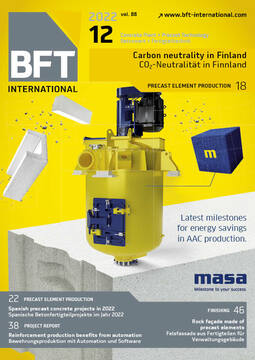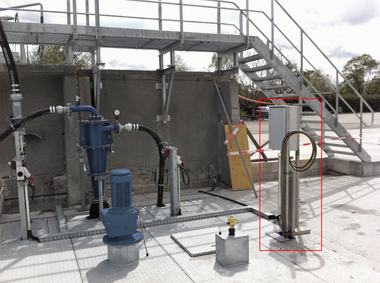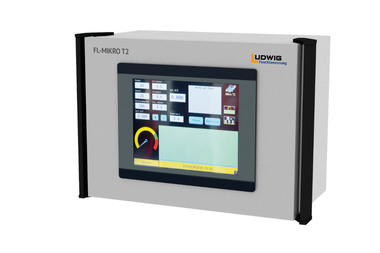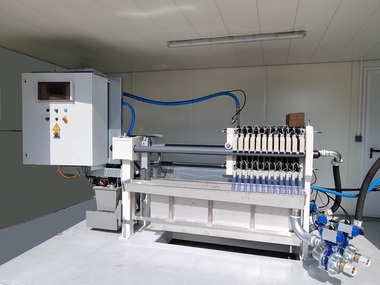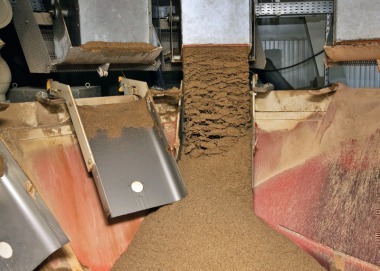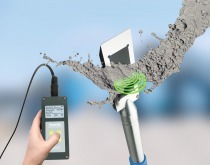Maximum consumption of residual water with 100 % quality reliability: cost savings thanks to the OLAS sensor
The OLAS measuring system is extremely robust and insensitive to the harsh operating conditions at the concrete plant. With more than 45 years of experience in the production of moisture measuring probes – for applications in the concrete industry too – greatest importance has also been attached to a practice-related solution right from the beginning as regards the OLAS. The OLAS systems made by Werne & Thiel Sensortechnik located in Wutöschingen have been used in concrete plants throughout Europe with success for more than twelve years now.
Optical Light Absorption Sensor
The name OLAS stands for Optical Light Absorption Sensor and the function is based on infrared absorption measurement. The IR light transmitted by means of a fiber optic cable penetrates the measuring medium, the loss of light owing to absorption is evaluated and is transmitted as a density signal.
The co-owner Walter Werne states: "We developed the sensor not only at the desk, but together with our customers under harsh and realistic operating conditions. In this process, we have paid particular attention to robust and practice-oriented technology, low maintenance and cleaning requirements as well as high ease of servicing. Combined with its unique high-tech electronics, the OLAS system offers an unbeatable value for money."
Environment and sustainability
Using the OLAS system makes a substantial contribution to active environmental protection by adding an as high as possible portion of residual water to the concrete mixture, so as to avoid the need of expensive treatment or disposal.
The following article explains in detail how the comprehensive use of the senor does not only save fresh water, but also filling materials and possibly also cement.
Benefit and use of OLAS
The objective is to make optimum use of the portion of residual water, thus saving costs for the disposal, treatment etc. In the meantime, many concrete types have become so sensitive that a simple table for the permitted addition of residual water is usually no longer sufficient. This means that the plant operator would have to use a different amount for almost every type of concrete, to achieve a maximum consumption of the residual water. In practice, this is not feasible for the mixing plant operator who, in most cases, is fully occupied by control and organizational processes – among others due to lack of time. To stay always on the safe side, in many cases, he will not use any – or fewer residual water than would be permitted by the concrete laboratory for the respective type.
This is an important factor for using the OLAS system, which by way of automation of this process reduces the pressure on the mixing plant operator and adds an optimum amount of residual water.
The high-precision online measurement of the residual water just being proportioned in the feed line to the weighing unit allows for the production of the density permitted by the concrete laboratory for the current type to be already achieved in the weighing unit by the addition of fresh water. This process is running fully automatically due to processing the OLAS signal in the control system. In this way, the use of residual water is also possible for much more and more sensitive concrete types, even if the actual density in the basin would be too high at the moment.
Owing to this larger withdrawal of residual water, consequently the basins are no longer consistently full to the brim. Hence, it is often possible to keep the density of the residual water already in the stirring vessel on a lower level by adding fresh water and thus being suitable for much more concrete types.
Additional possibilities for the improvement of concrete quality and saving of raw materials
In case of a residual water content of 1000 kg and a residual water density of 1.07, the solids content amounts to about 134 kg, then the water content is only 936 l.
This, otherwise not detected, incorrect dosing can be corrected in terms of quantity by the control system with the aid of the OLAS measurement.
Therefore, the consistent concrete quality is ensured with every batch and a not insignificant amount of sand, filling materials and possibly also cement can be saved.
CONTACT
Werne & Thiel Sensortechnik
Untere Muehlewiesen 2a
79793 Wutoeschingen/Germany
+49 7756 2425
info@werne-thiel.de
www.werne-thiel.de





